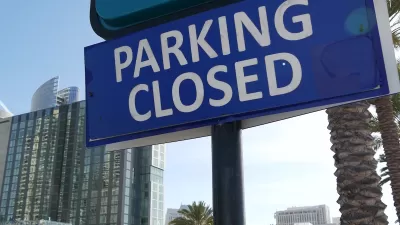Cities around the world are finding ways to go on a parking diet, freeing up unused space. San Francisco and Philadelphia are two U.S. leaders, while cities like Paris, Copenhagen, and Zurich pursue even more aggressive measures.

Though it's necessary in cities designed around the car, the way most cities provide for parking is hardly efficient. "'As parking regulations were put into zoning codes, most of the downtowns in many cities were just completely decimated,' says Michael Kodransky, global research manager for the Institute of Transportation and Development Policy. “What the cities got, in effect, was great parking. But nobody goes to a city because it has great parking.'"
The first step toward addressing the problem is simply measuring it. From Nate Berg's article: "Knowing the parking inventory has made it easier for the city to pursue public space improvements such as adding bike lanes or parklets, using the data to quell inevitable neighbourhood concerns about parking loss."
Invoking UCLA parking guru Donald Shoup, Berg writes, "After San Francisco implemented a pilot project with real-time data on parking availability and dynamic pricing for spaces, an evaluation found that the amount of time people spent looking for parking fell by 43%." Philadelphia's efforts to inventory parking have also led to space gains.
Outside the U.S., many cities have undertaken more aggressive strategies. "In 1996, [Zurich, Switzerland] decreed that there would be no more parking: officials placed a cap on the amount of parking spaces that would exist there, putting in place a trading system by which any developer proposing new parking spaces would be required to remove that many parking spaces from the city's streets."
Since 2003, Paris eliminated roughly 15,000 above-ground parking spaces. "São Paulo, for instance, got rid of its minimum parking requirements and implemented a maximum that could be built into specific projects. Beijing, Shenzhen and Guangzhou are hoping to emulate San Francisco's dynamic pricing approach."
FULL STORY: Lots to lose: how cities around the world are eliminating car parks

Depopulation Patterns Get Weird
A recent ranking of “declining” cities heavily features some of the most expensive cities in the country — including New York City and a half-dozen in the San Francisco Bay Area.

California Exodus: Population Drops Below 39 Million
Never mind the 40 million that demographers predicted the Golden State would reach by 2018. The state's population dipped below 39 million to 38.965 million last July, according to Census data released in March, the lowest since 2015.

Chicago to Turn High-Rise Offices into Housing
Four commercial buildings in the Chicago Loop have been approved for redevelopment into housing in a bid to revitalize the city’s downtown post-pandemic.

How California Transit Agencies are Addressing Rider Harassment
Safety and harassment are commonly cited reasons passengers, particularly women and girls, avoid public transit.

Significant Investments Needed to Protect LA County Residents From Climate Hazards
A new study estimates that LA County must invest billions of dollars before 2040 to protect residents from extreme heat, increasing precipitation, worsening wildfires, rising sea levels, and climate-induced public health threats.

Federal Rule Raises Cost for Oil and Gas Extraction on Public Lands
An update to federal regulations raises minimum bonding to limit orphaned wells and ensure cleanup costs are covered — but it still may not be enough to mitigate the damages caused by oil and gas drilling.
City of Costa Mesa
Licking County
Barrett Planning Group LLC
HUD's Office of Policy Development and Research
Mpact Transit + Community
HUD's Office of Policy Development and Research
City of Universal City TX
ULI Northwest Arkansas
City of Laramie, Wyoming
Urban Design for Planners 1: Software Tools
This six-course series explores essential urban design concepts using open source software and equips planners with the tools they need to participate fully in the urban design process.
Planning for Universal Design
Learn the tools for implementing Universal Design in planning regulations.






















